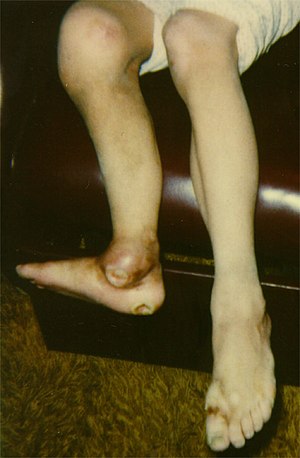Congenital insensitivity to pain with anhidrosis
| Congenital insensitivity to pain with anhidrosis | |
|---|---|
| Other names: hereditary sensory and autonomic neuropathy type IV | |
 | |
| Charcot joints are shown in this boy with CIPA. His right knee and right ankle are enlarged and distorted. The skin over the medial aspect of the ankle is darkened with a draining wound secondary to superimposed osteomyelitis. There are other areas of trauma and ulcers including a site on the right heel. | |
| Specialty | Neurology |
| Causes | Genetic mutations |
Congenital insensitivity to pain with anhidrosis (CIPA) is a rare autosomal recessive disorder of the nervous system which prevents the feeling of pain or temperature, and prevents a person from sweating. Cognitive disorders are commonly coincident. CIPA is the fourth type of hereditary sensory and autonomic neuropathy (HSAN), and is also known as HSAN IV.
Signs and symptoms

Signs of CIPA are present from infancy. Infants may present with seizures related to an abnormally high body temperature. Since people with this condition are unable to sweat, they are unable to properly regulate their body temperature.[1] Those affected are unable to feel pain and temperature.[citation needed]
The absence of pain experienced by people with CIPA puts them at high risk for accidental self-injury. Corneal ulceration occurs due to lack of protective impulses.[2] Joint and bone problems are common due to repeated injuries, and wounds heal poorly.[3]
Cause
CIPA is caused by a genetic mutation that prevents the formation of nerve cells which are responsible for transmitting signals of pain, heat, and cold to the brain. The disorder is inherited in an autosomal recessive fashion.[citation needed]
CIPA is caused by a mutation in NTRK1, a gene encoding the neurotrophic tyrosine kinase receptor.[4] NTRK1 is a receptor for nerve growth factor (NGF). This protein induces outgrowth of axons and dendrites and promotes the survival of embryonic sensory and sympathetic neurons. The mutation in NTRK1 does not allow NGF to bind properly, causing defects in the development and function of nociceptive reception.[5]
Mitochondrial abnormalities in muscle cells have been found in people with CIPA. Skin biopsies show a lack of innervation of the eccrine glands[2] and nerve biopsies show a lack of small myelinated and unmyelinated fibers.[2][6]
Diagnosis
Diagnosis is made based on clinical criteria and can be confirmed with genetic testing.[1]
Treatment
There is no treatment for CIPA. Attention to injuries to prevent infection and worsening is necessary.[1]
Epidemiology
The condition is inherited and is most common among Negev Arabs aka Negev Bedouins.[2] Approximately 20% of people with CIPA die of hyperthermia by age 3.[2]
References
- ↑ 1.0 1.1 1.2 Fenichel's Clinical Pediatric Neurology (6th ed.). Elsevier. 2013. pp. 207–214.
- ↑ 2.0 2.1 2.2 2.3 2.4 Tachdjian's Pediatric Orthopaedics (5th ed.). Saunders Elsevier. 2014. pp. 285–319.
- ↑ Swaiman's Pediatric Neurology (6th ed.). Elsevier. 2017. pp. e2652–e2669.
- ↑ Shatzky S, Moses S, Levy J, et al. (June 2000). "Congenital insensitivity to pain with anhidrosis (CIPA) in Israeli-Bedouins: genetic heterogeneity, novel mutations in the TRKA/NGF receptor gene, clinical findings, and results of nerve conduction studies". Am. J. Med. Genet. 92 (5): 353–60. doi:10.1002/1096-8628(20000619)92:5<353::AID-AJMG12>3.0.CO;2-C. PMID 10861667.
- ↑ Indo, Yasuhiro (1996). "Mutations in the TRKA/NGF Receptor Gene in Patients with Congenital Insensitivity to Pain with Anhidrosis" (PDF). Nature Genetics. Kumamoto University. 13 (4): 485–8. doi:10.1038/ng0896-485. PMID 8696348. S2CID 2849827. Archived from the original (PDF) on 18 May 2019. Retrieved 7 December 2011.
- ↑ Volpe's Neurology of the Newborn (6 ed.). Elsevier. 2018. pp. 887–921.
Further reading
- Indo, Y; Pagon, RA; Adam, MP; Ardinger, HH; Wallace, SE; Amemiya, A; Bean, LJH; Bird, TD; Ledbetter, N; Mefford, HC; Smith, RJH; Stephens, K (1993). "Congenital Insensitivity to Pain with Anhidrosis". University of Washington, Seattle. PMID 20301726. Archived from the original on 26 July 2018. Retrieved 8 July 2017.
{{cite journal}}: Cite journal requires|journal=(help)
| Classification | |
|---|---|
| External resources |
- Pages with script errors
- All articles with unsourced statements
- Articles with unsourced statements from April 2020
- Articles with invalid date parameter in template
- Articles with unsourced statements from September 2020
- CS1 errors: missing periodical
- Autosomal recessive disorders
- Neurocutaneous conditions
- Peripheral nervous system disorders
- Rare diseases